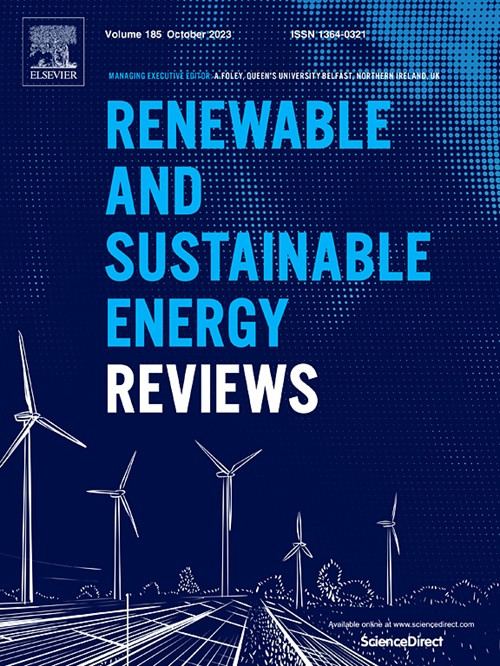Stochastic techno-economic assessment of a grid-connected rooftop photovoltaic in Iran
IF 16.3
1区 工程技术
Q1 ENERGY & FUELS
引用次数: 0
Abstract
This study examines the technical and economic performance of a grid-connected rooftop photovoltaic system with a nominal capacity of 8456 kW. The analysis is based on a case study of an industrial plant in Iran, considering both the feed-in tariff and time-of-use scheme. A three-stage approach is employed, utilizing a combination of MATLAB software, PVsyst, and HOMER Grid. To account for load and renewable energy sources uncertainties, scenario-based and backward methods are employed to generate a manageable set of relevant scenarios. Given the project’s 25-year lifespan, a sensitivity analysis is conducted to assess the impact of varying annual grid electricity tariff increases. In the first step, using MATLAB, scenarios are created to account for uncertainty. In the second stage, based on the data from the previous stage, the design and technical analysis of the PV system evaluated using PVsyst software. Finally, in the third stage, the economic analysis of the proposed system is performed in HOMER grid software, using the outputs from the previous two stages. The simulated PV system achieved an average performance ratio of 80.4%. Additionally, the system has the potential to reduce CO2 emissions by 188,611.595 tons over its lifetime. Furthermore, the economic analysis, incorporating a comprehensive sensitivity analysis of key factors such as grid tariff increases, PV degradation, and inflation rates, indicates that the proposed system’s net present cost becomes lower than that of relying solely on grid electricity if the annual grid tariff increase exceeds 10%.
伊朗并网屋顶光伏电站的随机技术经济评估
本研究考察了一个标称容量为8456千瓦的并网屋顶光伏系统的技术和经济性能。该分析基于对伊朗一家工业工厂的案例研究,同时考虑了上网电价和分时电价方案。采用三阶段方法,结合MATLAB软件、PVsyst和HOMER Grid。为了考虑负荷和可再生能源的不确定性,采用基于场景和反向的方法来生成一组可管理的相关场景。考虑到该项目的25年寿命,进行了敏感性分析,以评估不同年度电网电价上涨的影响。在第一步,使用MATLAB,创建场景来考虑不确定性。第二阶段,在前一阶段数据的基础上,利用PVsyst软件对光伏系统进行设计和技术分析评估。最后,在第三阶段,利用前两个阶段的输出,在HOMER网格软件中对所提出的系统进行经济分析。模拟光伏系统的平均性能比达到80.4%。此外,该系统在其生命周期内有可能减少188,611.595吨的二氧化碳排放。此外,结合电网电价上涨、光伏退化和通货膨胀率等关键因素的综合敏感性分析,经济分析表明,如果电网电价年涨幅超过10%,拟议系统的净当前成本将低于单纯依赖电网供电的系统。
本文章由计算机程序翻译,如有差异,请以英文原文为准。
求助全文
约1分钟内获得全文
求助全文
来源期刊

Renewable and Sustainable Energy Reviews
工程技术-能源与燃料
CiteScore
31.20
自引率
5.70%
发文量
1055
审稿时长
62 days
期刊介绍:
The mission of Renewable and Sustainable Energy Reviews is to disseminate the most compelling and pertinent critical insights in renewable and sustainable energy, fostering collaboration among the research community, private sector, and policy and decision makers. The journal aims to exchange challenges, solutions, innovative concepts, and technologies, contributing to sustainable development, the transition to a low-carbon future, and the attainment of emissions targets outlined by the United Nations Framework Convention on Climate Change.
Renewable and Sustainable Energy Reviews publishes a diverse range of content, including review papers, original research, case studies, and analyses of new technologies, all featuring a substantial review component such as critique, comparison, or analysis. Introducing a distinctive paper type, Expert Insights, the journal presents commissioned mini-reviews authored by field leaders, addressing topics of significant interest. Case studies undergo consideration only if they showcase the work's applicability to other regions or contribute valuable insights to the broader field of renewable and sustainable energy. Notably, a bibliographic or literature review lacking critical analysis is deemed unsuitable for publication.
 求助内容:
求助内容: 应助结果提醒方式:
应助结果提醒方式:


